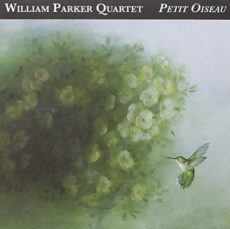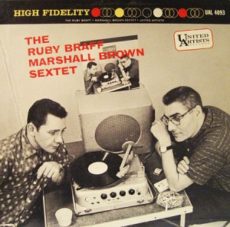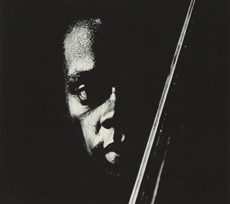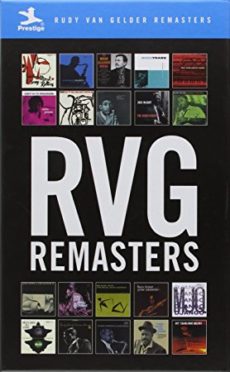
Daily Dose Of Jazz…
William Parker was born January 10, 1952 in the Bronx, New York. He was not formally trained as a classical player, though he did study with Jimmy Garrison, Richard Davis, and Wilbur Ware and learned the tradition and is one of few jazz bassists who frequently plays arco.
Active on the free jazz scene since the early Seventies, Parker first came to public attention with pianist Cecil Taylor. The 1990s saw Parker’s prominence and public profile grow as an influential bassist in the New York City experimental jazz scene.
He has long been a member of saxophonist David S. Ware’s quartet, in Peter Brötzmann’s groups and has also played with various other groups that included Paul Murphy. He is a member of the cooperative Other Dimensions In Music and together with his wife, Patricia Nicholson Parker, organizes the annual Vision Festival in New York City.
His Sound Unity album has been listed in the Top 10o and his Double Sunrise over Neptune made the Top 10 album pick list by Amazon, and his Petit Oiseau has been chosen as one of the best jazz disks of 2008 by The Wall Street Journal, the BBC’s Radio Three, The Village Voice and PopMatters.
In 2006, Parker was awarded the Resounding Vision Award from Nameless Sound. His first book, Who Owns Music?, assembles his political thoughts, poems, and musicological essays In June 2011, while his second book, Conversations, is a collection of interviews with notable free jazz musicians and forward thinkers, mainly from the African-American community.
Free jazz bassist William Parker continues to record and perform regularly at music festivals around the world.
![]()
#preserving genius
More Posts: bass

Daily Dose Of Jazz…
Reuben Radding was born on December 29, 1966 in Washington, DC and began his musical career in the DC punk scene. After moving to New York City in 1988, he studied double bass with Mark Dresser and composition with Edgar Grana, who were strong influence on his musical development as well as William Parker.
He played in various genres from avant-garde jazz to swing, folk, pop, Klezmer and chamber music with musicians such as John Zorn, Elliott Sharp, Anthony Coleman, Andrea Parkins, Dave Douglas, Roy Campbell and Rashid Bakr. With Marc Ribot he toured Europe and Canada in 1995 and leading his own band Myth Science, he played compositions by Sun Ra. He recorded the album Love in Outer Space at the Knitting Factory. Radding co-founded the experimental trio Refuseniks with John Hollenbeck and Ted Reichman .
By early 1997 he moved to Seattle, Washington playing in the trio of alto saxophonist Wally Shoup, and performing improvisationally with musicians Saadet Türköz , Carlo Actis Dato and Wolfgang Fuchs . In 2001 he performed in a duet with Daniel Carter on the Earshot Jazz Festival, and in 2003 gained international notoriety with his release of Luminescence.
He has recorded albums with Ursel Schlicht , Stephen Gauci, Carlos Bechegas, Nate Wooley, Mary Halvorson, Frank London and Tomas Fujiwara. Currently back in New York, bassist Reuben Radding performs and records with his trio comprised of vibraphonist Matt Moran and clarinetist Oscar Noriega, as well as with an improvising trio with Tara Flandreau and Carrie Shull, and operates Pine Ear Music label.
![]()
More Posts: bass

Daily Dose Of Jazz…
Marshall Brown was born on December 21, 1920 in Framingham, Massachusetts. Little recorded, he devoted most of his career to education, earning a music degree from New York University, as a member of the Zeta Psi Fraternity.
He was also a high school band director leading the Farmingdale New York Daler Band from the early 1950s through 1957. Brown was the first high school band director to initiate a jazz education program, which he did in his tenure at Farmingdale High. By 1956 his stage band, the Daler Dance Band, a jazz big band with an average age of 14 years old, was so formidable and impressive, boasted future jazz stars pianist Michael Abene, saxophonist Andrew Marsala, and whiz drummer Larry Ramsden. One night at the 1957 Newport Jazz Festival, Count Basie, who was late for his appearance as he entered the festival grounds heard the Daler Band performing their set and exclaimed, “Damn, they started already”, mistaking the Dalers for his band.
Marshall received some attention for performing and recording in a quartet with Pee Wee Russell in the early 1960s. While Russell was most often associated with Dixieland or swing, their quartet performed more adventurous, free jazz-oriented pieces, including pieces by Ornette Coleman and John Coltrane.
During the Sixties he was the resident trombonist at Jimmy Ryan’s, a noted dixieland venue. He also club dated with Luke O’Malley’s Irish band during this time. Brown also performed or recorded at one time or another with Ruby Braff, Beaver Harris, Lee Konitz, George Wein and Basie.
Conductor, arranger and educator Marshall Brown, who also played the valve trombone, trumpet, euphonium, electric bass and the banjo, passed away on December 13, 1983 in New York City.
![]()
More Posts: banjo,bass,euphonium,trombone,trumpet,valve trombone

Daily Dose Of Jazz…
Henry Grimes was born November 3, 1935 in Philadelphia, Pennsylvania and took up the violin at the age of 12, then began playing tuba, English horn, percussion, and finally the double bass in high school. He went on to study at Juilliard, establishing a reputation as a versatile bassist by the mid-1950s.
At a time when bassist Charles Mingus was experimenting with a second bass player in his band, Grimes was the person he selected for the job. At twenty-two he was captured on film in the Bert Stern documentary of the 1958 Newport Jazz Festival’s Jazz on a Summer’s Day and as word spread among the musicians about his extraordinary playing, he ended up playing with six different groups in the festival that weekend: those of Benny Goodman, Lee Konitz, Thelonious Monk, Gerry Mulligan, Sonny Rollins, and Tony Scott.
Gradually growing interested in the burgeoning free jazz movement, Henry performed with most of the music’s important names, including Cecil Taylor, Don Cherry, Steve Lacy, Pharoah Sanders, Archie Shepp, and Albert Ayler. He released one album, The Call, as a trio leader on the ESP-Disk label in 1965 with clarinetist Perry Robinson and drummer Tom Price. By the late 1960s, he moved to California, his career came to a halt and after more than a decade of activity and performance, notably as a leading bassist in free jazz, completely disappeared from the music scene by 1970 and was often presumed dead.it was commonly assumed Grimes had died, having been listed as such in several jazz reference works.
Fortunately Henry was discovered him in 2002 alive but nearly destitute by Marshall Marrotte, a social worker and jazz fan. He was without a bass to play, renting a tiny apartment in Los Angeles, California, writing poetry and doing odd jobs to support himself. He had fallen so out of touch with the jazz world that he was unaware Albert Ayler had died in 1970.
Since his return in 2003 to a hero’s welcome at the free jazz Vision Festival, he has been performing at festivals, teaching lessons and workshops for bassists. William Parker donated a bass nicknamed “Olive Oil” for its distinctive greenish color and with David Gage’s help had it shipped from New York to Los Angeles, and others assisted with travel expenses and arranging performances.
Grimes has made up for lost time and over the course of his career, old and new, he has recorded over 90 sessions and performed with Anita O’Day, Mose Allison, Roy Burns, Andrew Cyrille, Paul Dunmall – Profound Sound Trio, , Walt Dickerson, Shafi Hadi, Roy Haynes, Rolf Kühn, Carmen Leggio, William Parker, Marc Ribot, Pharoah Sanders, Shirley Scott, Marilyn Crispell, Ted Curson, Archie Shepp, Billy Taylor, Cecil Taylor, Marshall Allen, Fred Anderson, Lennie Tristano, McCoy Tyner, Rashied Ali, Bill Dixon, Dave Douglas, Andrew Lamb, Joe Lovano, Roscoe Mitchell, William Parker, High Priest, Wadada Leo Smith, Cecil Taylor John Tchicai, and numerous others.
In the past few years, Grimes has also held a number of residencies and offered workshops and master classes at City College of New York, Berklee College of Music, Hamilton College, New England Conservatory, the University of Michigan at Ann Arbor, the University of Gloucestershire at Cheltenham, Humber College, and more. He has released or played on a dozen new recordings, made his professional debut on a second instrument, the violin, at Cecil Taylor’s side at Lincoln Center at the age of 70, and has been creating illustrations to accompany his new recordings and publications. He has received many honors in recent years, including four Meet the Composer grants and a Lifetime Achievement Award from Arts for Art / Vision Festival.
Bassist, violinist, composer and poet Henry Grimes is now a resident of New York City and has a busy schedule of performances, clinics, and international tours.
Sponsored By

Daily Dose Of Jazz…
Rudolph “Rudy” Van Gelder was born on November 2, 1924 in Jersey City, New Jersey. His interest in microphones and electronics can be traced to a youthful enthusiasm for amateur radio. Named for his uncle who had been the drummer in Ted Lewis’s band in the mid-1930s, he took trumpet lessons and trained as an optometrist at the Pennsylvania College of Optometry, in Philadelphia, thinking he could not earn a living as a recording engineer.
From 1943, after graduating, Van Gelder had an optometry practice in Teaneck, New Jersey, and moonlighted recording local musicians in the evenings who wanted 78-rpm recordings of their work. From 1946, Van Gelder recorded in his parents’ house in Hackensack, New Jersey, in which a control room was built adjacent to the living room, which served as the musicians’ performing area. The dry acoustics of this working space were partly responsible for Van Gelder’s inimitable recording aesthetic.
Interested in improving the quality of the playback equipment he acquired everything that could play back audio: speakers, turntables and amplifiers. One of Rudy’s friends, baritone saxophonist Gil Mellé, introduced him to Alfred Lion, a producer for Blue Note Records, in 1953. Within a few years he was in demand by many other independent labels based around New York City, such as Bob Weinstock, owner of Prestige Records. To accommodate each label – Blue Note, Prestige, Savoy, Impulse, Verve he assigned them to different days as Lion was more stringent with the sound of original music, Weinstock had essentially blowing sessions for some of the best musicians in jazz history.He also engineered and mastered for the classical label Vox Records in the Fifties.
Van Gelder worked during the day as an optometrist until the summer of 1959, when he moved his operations to a larger studio in Englewood Cliffs, New Jersey and became a full-time recording engineer. The new studio’s design was inspired by the work of Frank Lloyd Wright had high ceilings and fine acoustics with “no food or drink and do not touch microphones” policy as he himself always wore gloves when handling equipment.
By 1967 the labels were beginning to utilize other engineers more regularly but Rudy remained active engineering nearly all of Creed Taylor’s CTI Records releases, a series of proto-smooth jazz albums that were financially successful, but not always well received by critics. He was not without his detractors. Despite his prominence in the industry, like Lion who didn’t care for the overuse of reverb, and Charles Mingus refused to work with him because he change the sound of his bass. He remastered the analog Blue Note recordings into 24-bit digital recordings in its RVG Edition series and also remasters of some of the Prestige albums, and was happy to see the LP go by the wayside because it was hard for him to get the sound the way he thought it should be.
He received awards and honors being named a fellow of the Audio Engineering Society (AES), received the society’s most prestigious award, the AES Gold Medal, named a Jazz Master by the National Endowment for the Arts, received the Grammy Trustees Award, and Thelonious Monk composed and recorded a tribute to Van Gelder titled Hackensack.
Producer and recording engineer Rudy Van Gelder, who specialized in jazz and regarded as the most important recording engineer of jazz by some observers, passed away at home in Englewood Cliffs, New Jersey on August 25, 2016. Among the several thousand jazz sessions he recorded are the acknowledged classics John Coltrane’s A Love Supreme, Miles Davis’s Walkin’, Herbie Hancock’s Maiden Voyage, Sonny Rollins’s Saxophone Colossus and Horace Silver’s Song for My Father.
![]()



